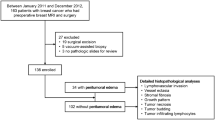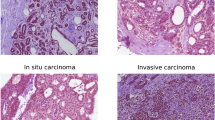Summary
Necrosis is a common feature of invasive carcinoma of the breast and is caused by chronic ischaemia leading to infarction. Although necrosis was previously assumed to be due to a generally poor blood supply in the tumour, in this study we show that it is present in tumours with focal areas of high vascular density situated away from the actual sites of necrosis. This may account, in part, for the previous observation that necrosis is linked to poor prognosis in this disease. Highly angiogenic tumours often display blood vessel shunting from one tumour area to another, which further exacerbates ischaemia and the formation of tumour necrosis. We have recently demonstrated that high focal microphage infiltration into breast tumours is significantly associated with increased tumour angiogenesis and poor prognosis and that the macrophages accumulate in poorly vascularized, hypoxic areas within breast tumours. In order to investigate the interactions of macrophages with chronic ischaemia (as reflected by the presence of necrosis) and angiogenesis in breast tumours, we quantified the levels of these three biological parameters in a series of 109 consecutive invasive breast carcinomas. We found that the degree of tumour necrosis was correlated with both microphage infiltration (Mann–Whitney U, P-value = 0.0009; chi-square, P-value = 0.01) and angiogenesis (Mann–Whitney U P-value = 0.0008, chi square P-value = 0.03). It was also observed that necrosis was a feature of tumours possessing an aggressive phenotype, i.e. high tumour grade (chi-square, P-value < 0.001), larger size (Mann–Whitney U, P-value = 0.003) and low oestrogen receptor status (Mann–Whitney U, P-value = 0.008; chi-square, P-value < 0.008). We suggest, therefore, that aggressive tumours rapidly outgrow their vascular supply in certain areas, leading to areas of prolonged hypoxia within the tumour and, subsequently, to necrosis. This, in turn, may attract macrophages into the tumour, which then contribute to the angiogenic process, giving rise to an association between high levels of angiogenesis and extensive necrosis.
Similar content being viewed by others
Article PDF
Change history
16 November 2011
This paper was modified 12 months after initial publication to switch to Creative Commons licence terms, as noted at publication
References
Blood, C. H. & Zetter, B. R. (1990). Tumor interactions with the vasculature: angiogenesis and tumor metastasis. Biochim Biophys Acta 1032: 89–118.
Clauss, M., Gerlach, M., Gerlach, H., Brett, J., Wang, F., Familletti, P. C., Pan, Y. C., Olander, J. V., Connolly, D. T. & Stern, D. (1990). Vascular permeability factor: a tumor-derived polypeptide that induces endothelial cell and monocyte procoagulant activity, and promotes monocyte migration. J Exp Med 172: 1535–1545.
Dachs, G. U. & Stratford, I. J. (1996). The molecular response of mammalian-cells to hypoxia and the potential for exploitation in cancer therapy. Br J Cancer 74: S126–S132.
Elston, C. W. (1987). Grading of invasive breast carcinomas. In Diagnostic Histopathology of the Breast, Page D Anderson T (eds). Churchill Livingstone: Edinburgh
European Breast Cancer Co-operative Group (1980). Revision of the standards for the assessment of hormone receptors in human breast cancer; report of the second EORTC Workshop, held on 16–17 March 1979, the Netherlands Cancer Institute. Eur J Cancer 16: 1513–1513.
Fisher, E. R., Anderson, S., Redmond, C. & Fisher, B. (1993). Pathologic findings from the National Surgical Adjuvant Breast Project protocol B-06. 10-year pathologic and clinical prognostic discriminants. Cancer 71: 2507–2514.
Forsythe, J. A., Jiang, B. H., Iyer, N. V., Agani, F., Leung, S. W., Koos, R. D. & Semenza, G. L. (1996). Activation of vascular endothelial growth-factor gene-transcription by hypoxia-inducible factor-1. Mol Cell Biol 16: 4604–4613.
Fox, S. B., Leek, R. D., Weekes, M. P., Whitehouse, R. M., Gatter, K. C. & Harris, A. L. (1995). Quantitation and prognostic value of breast cancer angiogenesis: comparison of microvessel density, Chalkley count, and computer image analysis. J Pathol 177: 275–283.
Harney, J. H., Dimitriadis, E., Kay, E., Redmond, H. P. & Bouchier-Hayes, D. (1998). Regulation of macrophage production of VEGF by hypoxia and TGF13-1. Ann Surg Oncol 5: 271–278.
Helmlinger, G., Yuar, F., Dellian, M. & Jain, R. K. (1997). Interstitial pH and pO2 gradients in solid tumors in vivo: high-resolution measurements reveal a lack of correlation. Nature Med 3: 177–182.
Kato, T., Kimura, T., Miyakawa, R., Tanaka, S., Fuji, A., Yamamoto, K., Kameoka, S., Hamano, K., Kawakami, M. & Aiba, M. (1997). Clinicopathologic study of angiogenesis in Japanese patients with breast cancer. World J Surg 21: 49–56.
Lee, A. H. S., Happerfield, L. C., Bobrow, L. G. & Millis, R. R. (1997). Angiogenesis and inflammation in invasive carcinoma of the breast. J Clin Pathol 50: 669–673.
Leek, R. D., Lewis, C. E., Whitehouse, R., Greenall, M., Clarke, J. & Harris, A. L. (1996). Association of macrophage infiltration with angiogenesis and prognosis in invasive breast-carcinoma. Cancer Res 56: 4625–4629.
Leek, R. D., Lewis, C. E. & Harris, A. L. (1997). The role of macrophages in tumour angiogenesis. In Tumour Angiogenesis, Bicknell R Lewis CE Ferrara N (eds), Oxford University Press: Oxford
Leek, R. D., Landers, R. J., Fox, S. B., Ng, F., Harris, A. L. & Lewis, C. E. (1998). Association of tumour necrosis factor alpha and its receptors with thymidine phosphorylase expression and metastasis in invasive carcinoma of the breast. Br J Cancer 77: 2246–2251.
Lewis, C. E., Leek, R. D., Harris, A. L. & McGee, J. O. D. (1995). Cytokine reguation of angiogenesis in breast cancer: the role of tumor-associated macrophages. J Leukoc Biol 57: 747–751.
Lewis, C. E. (1996). Regulation of tumour angiogenesis by macrophages: role of hypoxia and angiogenic factor production. Clin Exp Met 15: 74
Negus, R. P. M., Stamp, G. W. H., Hadley, J. & Balkwill, F. R. (1997). Quantitative assessment of the leukocyte infiltrate in ovarian cancer and its relationship to the expression of C-C chemokines. Am J Pathol 150: 1723–1734.
Nicholson, S., Sainsbury, J. R., Needham, G. K., Chambers, P., Farndon, J. R. & Harris, A. L. (1988). Quantitative assays of epidermal growth factor receptor in human breast cancer: cut-off points of clinical relevance. Int J Cancer 42: 36–41.
Plate, K. H. & Warnke, P. C. (1997). Vascular endothelial growth factor. J Neurooncol 35: 365–372.
Scannell, G., Waxman, K., Kaml, G. J., Ioli, G., Gatanaga, T., Yamamoto, R. & Granger, G. A. (1993). Hypoxia induces a human macrophage cell line to release tumour necrosis factor-alpha and its soluble receptors in vitro. J Surg Res 54: 281–285.
Semenza, G. L., Roth, P. H., Fang, H. M. & Wang, G. L. (1994). Transcriptional regulation of genes encoding glycolytic enzymes by hypoxia-inducible factor 1. J Biol Chem 269: 23757–23763.
Woolf, N. (1986). Cell and tissue death. In Cell, Tissue and Disease, The Basis of Pathology, pp. 25–30, Baillière Tindall: London
Author information
Authors and Affiliations
Rights and permissions
From twelve months after its original publication, this work is licensed under the Creative Commons Attribution-NonCommercial-Share Alike 3.0 Unported License. To view a copy of this license, visit http://creativecommons.org/licenses/by-nc-sa/3.0/
About this article
Cite this article
Leek, R., Landers, R., Harris, A. et al. Necrosis correlates with high vascular density and focal macrophage infiltration in invasive carcinoma of the breast. Br J Cancer 79, 991–995 (1999). https://doi.org/10.1038/sj.bjc.6690158
Received:
Revised:
Accepted:
Published:
Issue date:
DOI: https://doi.org/10.1038/sj.bjc.6690158
Keywords
This article is cited by
-
Prognostic value of tumor necrosis based on the evaluation of frequency in invasive breast cancer
BMC Cancer (2023)
-
Association of mast cell density, microvascular density and endothelial area with clinicopathological parameters and prognosis in canine mammary gland carcinomas
Acta Veterinaria Scandinavica (2022)
-
Machine learning with multiparametric breast MRI for prediction of Ki-67 and histologic grade in early-stage luminal breast cancer
European Radiology (2022)
-
Stem Cells in the Tumor Immune Microenvironment –Part of the Cure or Part of the Disease? Ontogeny and Dichotomy of Stem and Immune Cells has Led to better Understanding
Stem Cell Reviews and Reports (2022)
-
miR-151a-3p-rich small extracellular vesicles derived from gastric cancer accelerate liver metastasis via initiating a hepatic stemness-enhancing niche
Oncogene (2021)



